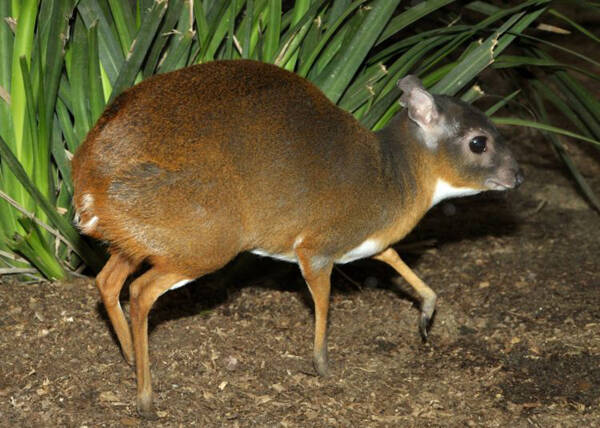Neotragus pygmaeus
IUCN
LCBasic Information
Scientific classification
- name:Neotragus pygmaeus
- Scientific Name:Neotragus pygmaeus
- Outline:Ungulata
- Family:Artiodactyla Bovidae Antelope
Vital signs
- length:40-50cm
- Weight:1.5-3kg
- lifetime:6-10years
Feature
One of the smallest ungulates
Distribution and Habitat
The Royal Island Oryx is endemic to the Guinea Forest. It is found in the Kounounkan Massif in southwestern Guinea and southeastern Guinea, Sierra Leone, Liberia, Côte d'Ivoire, and the Volta River in Ghana, with suspected records from forests east of the Volta River.
It inhabits moist lowland forests and secondary vegetation, forest edges and other denser scrubland, extending along gallery forests to forest and savanna blocks north of the main forest blocks. The Royal Island Oryx is encountered more often in log forests than in primary forests, and is also frequently encountered in farm scrublands. It lives in dense woodlands and scrublands, and is occasionally found in forests and farmlands along roads. Despite the high risk of hunting, the species persists in areas cultivated by humans.
Appearance
The Royal Island Oryx has a head-body length of 40-50 cm, a shoulder height of 25 cm, and a tail length of 5-8 cm; it weighs 1.5-3 kg. It is one of the smallest ungulates, about the size of a rabbit. The legs are long and thin; the hind legs are much longer than the front legs, which makes the body look hunched over. The soft fur is reddish-brown. The underparts, including the chin and the insides of the legs are white, but there is a brown band across the chest and white underbelly. The thin tail ends in a tuft of white hair. The male Royal Island Oryx has a pair of very small black horns, which are smooth and conical, and can reach a maximum length of 3.5 cm.
Details
Royal Antelope (scientific name: Neotragus pygmaeus) English Royal Antelope, French Antilope royale, German Kleinstbokchen, no subspecies.

The Bess Island Antelope is very similar to the Royal Antelope, but is only found in central Africa. The Baird's Island Oryx has small black and white markings on its ears and is slightly larger and darker than the Royal Island Oryx. The Royal Island Oryx is also similar in size and appearance to the mouse deer that live in Asia. Unlike the Royal Island Oryx, the mouse deer has a very distinct white stripe on its throat.

Royal Island Oryx calves are usually born between November and December. The calves weigh no more than 300 grams at birth, have the same color as the adults, and are weaned at about 2 months old. It is estimated that the life expectancy of this antelope in the wild is about 6 years, and can reach 10 years in captivity.
The Royal Island Oryx is reported to be abundant throughout its range, with a density of 0.2-2.0 individuals per square kilometre in a 1999 survey, which gives a total population estimate of 62,000 individuals. However, it is acknowledged that this is probably a serious underestimate. Population trends are difficult to assess but are apparently stable in at least some protected areas. Overall, it is probably declining as the species population grows and the associated pressures on natural habitats and wildlife increase throughout much of its range (East 1999).
Significant threats to the Royal Island Oryx are difficult to identify but are certainly threatened by bushmeat consumption. However, human attitudes to the species vary in different parts of its range. For example, people rarely shoot them in Sierra Leone but are sometimes caught in snares set for other animals. In Liberia, it is seen as the epitome of farmer cunning, and there is a general taboo against hunting or eating the Royal Island Oryx among the country's clans and ethnic groups. In contrast, in Côte d'Ivoire, it is an important component of bushmeat (1999), while in Kumasi, Ghana, 1,200 Royal Island Oryx individuals were recorded to be sold annually (Wilson 2001). Despite the impact of habitat destruction, it can survive in relatively small forests in areas with developed agriculture.
Listed in the IUCN Red List of Threatened Species in 2016 ver3.1 - Least Concern (LC).
Protect wildlife and eliminate bushmeat.
Maintaining ecological balance is everyone's responsibility!








